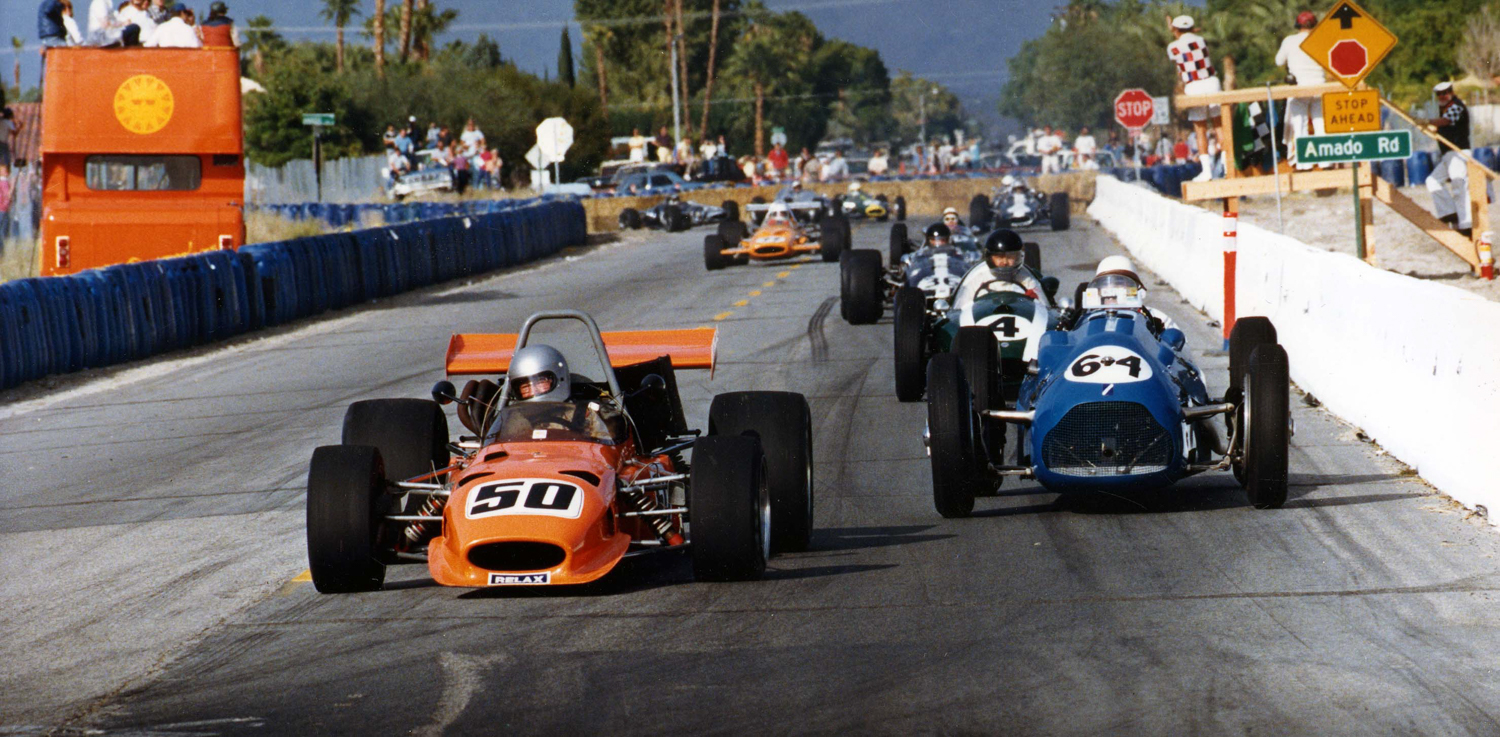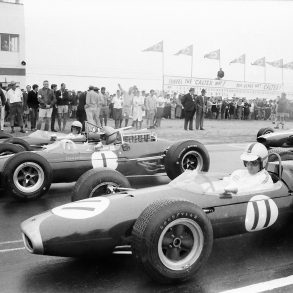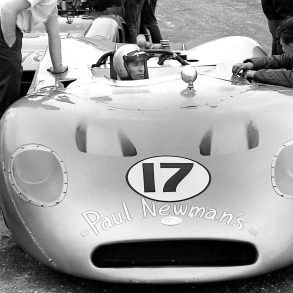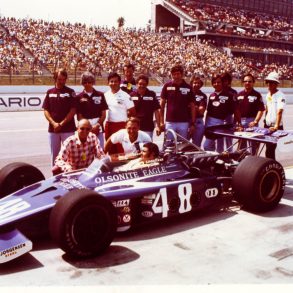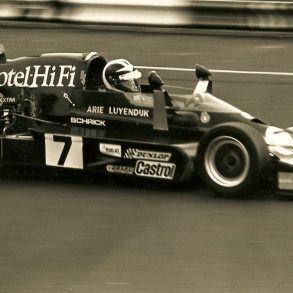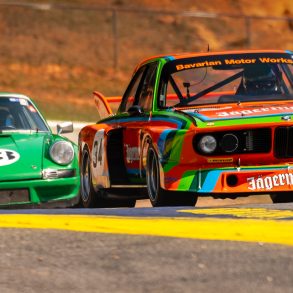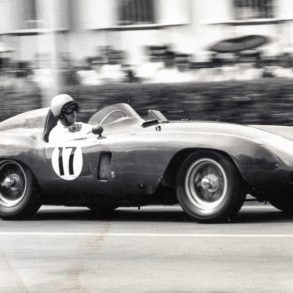Some 38 years ago, there was a vintage event like no other. It was the 1985 Palm Springs Vintage Grand Prix. Why was it so different? Would you believe 19 Formula One and Indy veterans on the same grid, all in competitive open-wheel cars? How about Dan Gurney in his Spa-winning Eagle! Or Bobby Unser in his 1975 F5000 Eagle! Stirling Moss in a Lotus, the twin of the car in which he won the 1962 Grand Prix of Monaco! You get the idea. Another event that weekend we called the Fabulous ‘50s Reunion featured more than 50 drivers who raced during the ’50s, most in the same or similar cars. Afterwards, Carroll Shelby said, “I don’t know how this came about, but it’s not likely to happen again.” Road & Track’s article stated that “It may turn out to be the most successful vintage car race ever held on this continent.”

Actually, it was my idea and I ended up as the promoter. Here’s how it developed: For quite a few years, Johnny Von Neumann, Vasek Polak and I had second homes in Palm Springs. All three of us were on the same street within walking distance of one another. So it was natural that we would get together now and then.
During the 1984 Thanksgiving holiday, we were gathered at Vasek’s celebrating with wine and tall stories, some about races we used to have in Palm Springs during the ’50s. The first post-WWII sports car road race held in Southern California was at Palm Springs on April 16, 1950. Johnny Von Neumann blew the head gasket on his supercharged MG, so he borrowed a Riley to compete in the production race. He was also a race official along with Chief Steward Ralph De Palma and Starter Peter De Palo! (Some believe this was the first in the West. Not so. On November 20, 1949, the MG Car Club held a race at Buchanan Field near Concord in Northern California.) The first few Palm Springs meets were on city streets. It wasn’t until 1953 that the course was laid out on airport runways.
Having imbibed way too much wine, I mumbled, “Why don’t we do it again?” Vasek thought it was a great idea; Johnny just said, “Harrumph.” With more enthusiasm than sense, the next day Vasek and I drove all around looking to see if there was a possible location for a course. In those days, the city wasn’t nearly as built up as it is now. We knew that a course couldn’t go past private homes, thus blocking ingress and egress. Eventually, we settled on streets between the then new convention center and Sunrise Way.
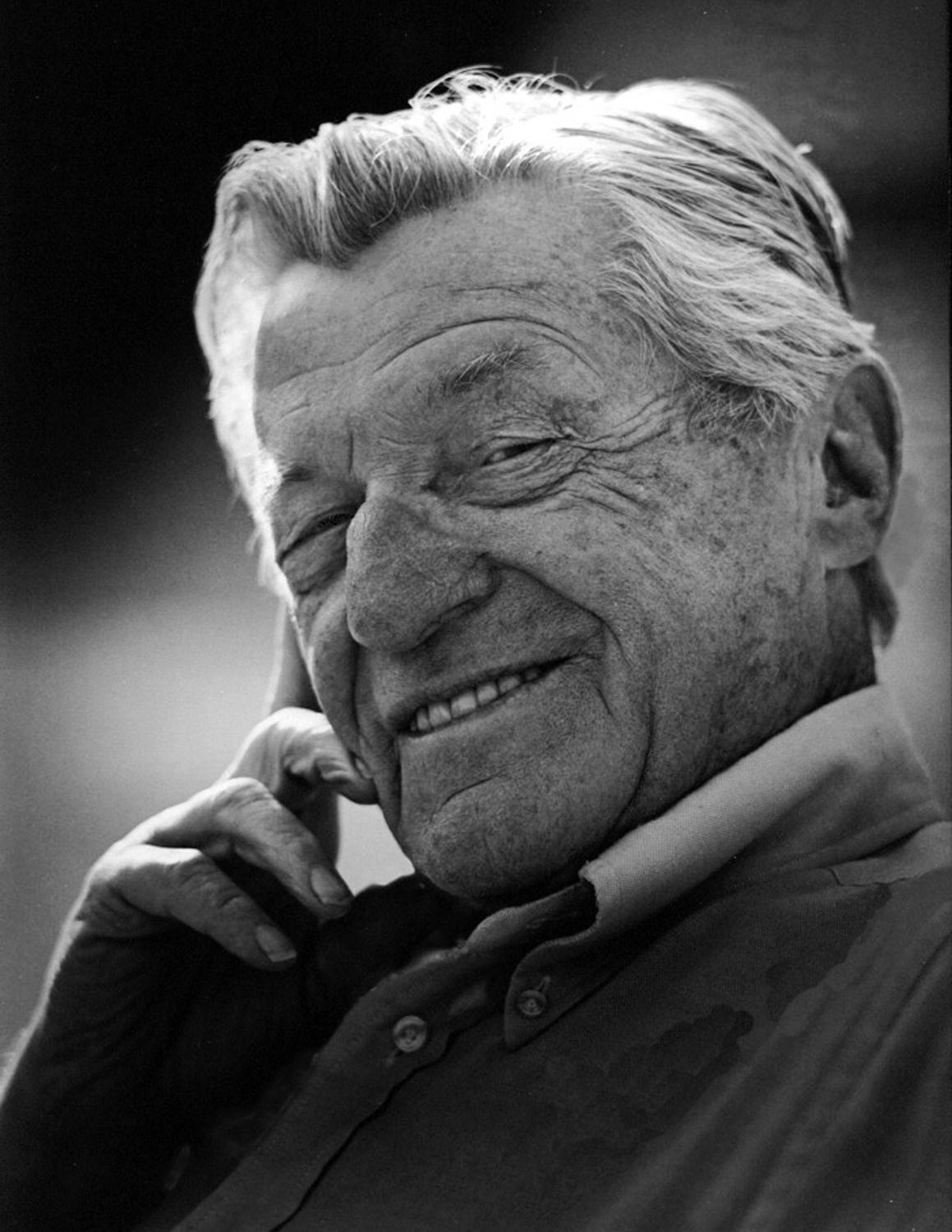
Now that we had a possible venue, what next? Obviously we needed permission and cooperation from the city. As it turned out, the mayor was a boyhood friend of mine; both of us had belonged to a hiking club. So on the Monday after the holiday, I went to have a chat with Mayor Frank Bogert. He was Mr. Palm Springs then; he’s gone now, but there’s a large statue of him on his horse in front of city hall. Frank had been around so long that he was on the city council during the ’50s and remembered the races. The idea I proposed was to have a vintage event with many of the cars and drivers that were there in the old days.
At that time, Palm Springs was struggling to attract visitors, particularly during the off season. Frank liked the idea and remembered that in the old days, the Chamber of Commerce along with the California Sports Car Club were the sponsors. So Frank called the Chamber manager, said it was ok to use city streets and told him to make it happen. In those days, in Palm Springs, whatever Frank said went.
Having never been to a vintage race, my idea was for it to be a re-creation; something like a live museum exhibit. Obviously, I needed to get a racing club involved. The Cal Club and the SCCA were not into vintage, but there was (and still is) an organization based in Southern California, the Vintage Auto Racing Association (VARA). I was invited to present the idea at the next board meeting. Although I got tentative approval (based on getting insurance), the meeting went on into the early morning. (That made me remember why I had declined to run for another term on the ’50s -era SCCA-LA Region board.)
The VARA board appointed their permanent race chairman, Cliff Jones to coordinate. The Chamber board appointed one of its members, my Palm Springs neighbor, Keith McCormick. We decided that the weekend after Thanksgiving, in 1985, would be a good date. It was a time when the city needed more visitors.
I had never attended a vintage race, so I went to a VARA event at Riverside. It was nice, but there were no spectators! Uh oh, I thought. Frank’s, the Chamber’s and Palm Spring’s idea was to attract visitors who would rent rooms, eat, drink and shop. In order to avoid getting ridden out of town on a rail, somehow I had to attract spectators. Stars and famous personalities are an attraction for most happenings. “So,” I thought, “I’ve got to get stars. But how?”

Even though they stopped racing some 50 years ago, there are two motorsports names known by almost everyone anywhere: Stirling Moss and Carroll Shelby. The two are unique in this respect. Ask anyone the name of that German guy who won so many World Championships. What’s his name? But every aficionado and many of the unwashed have at least heard of Moss and Shelby. Lucky for me, my family and the Moss family are friends. So one of the first things I did was call Stirling and tell him what I had in mind. Maybe because of the time of the year, Stirling agreed to come so long as I could provide first-class accommodations and airfare for his wife Susie, plus Innes Ireland and his girlfriend. “Great,” I thought, “I get Innes too!”
As it happened, the wife of a friend worked at British Airways. Through her, I got BA to provide four comps so long as it could host a party in the infield for local travel agents. The Chamber agreed, so I had the tickets. Having done some PR for the SCCA Region during the ’50s, I knew I had to have media ink to get spectators, So I compiled a mailing list of appropriate news outlets, sent a press release announcing the event and that Stirling and Innes were coming. I got a few hits including AutoWeek and Road & Track.
“But,” I thought, “just having Stirling and Innes standing around won’t make much of a show. I’ve got to have something for them to do that people will want to watch.” Since both were F1 drivers, how about a feature event called “Vintage Formula One?” But only those two plus a bunch of no-name vintage drivers wouldn’t do it. I needed more stars, as well as appropriate cars for them to drive.
A number of friends lived in Southern California then: Phil Hill, Sam Hanks, Rodger Ward and Dan Gurney. I got them to agree, so long as I could provide expenses and suitable vehicles. I sent out another press release and got more hits. By now, it was getting pretty complex and time consuming. As it happened, I had just sold my business, so I had the time and funds to survive without a day job. Plus I enlisted my neighbors Ginny and John Dixon to help. John had driven with the Cal Club during the ’50s.
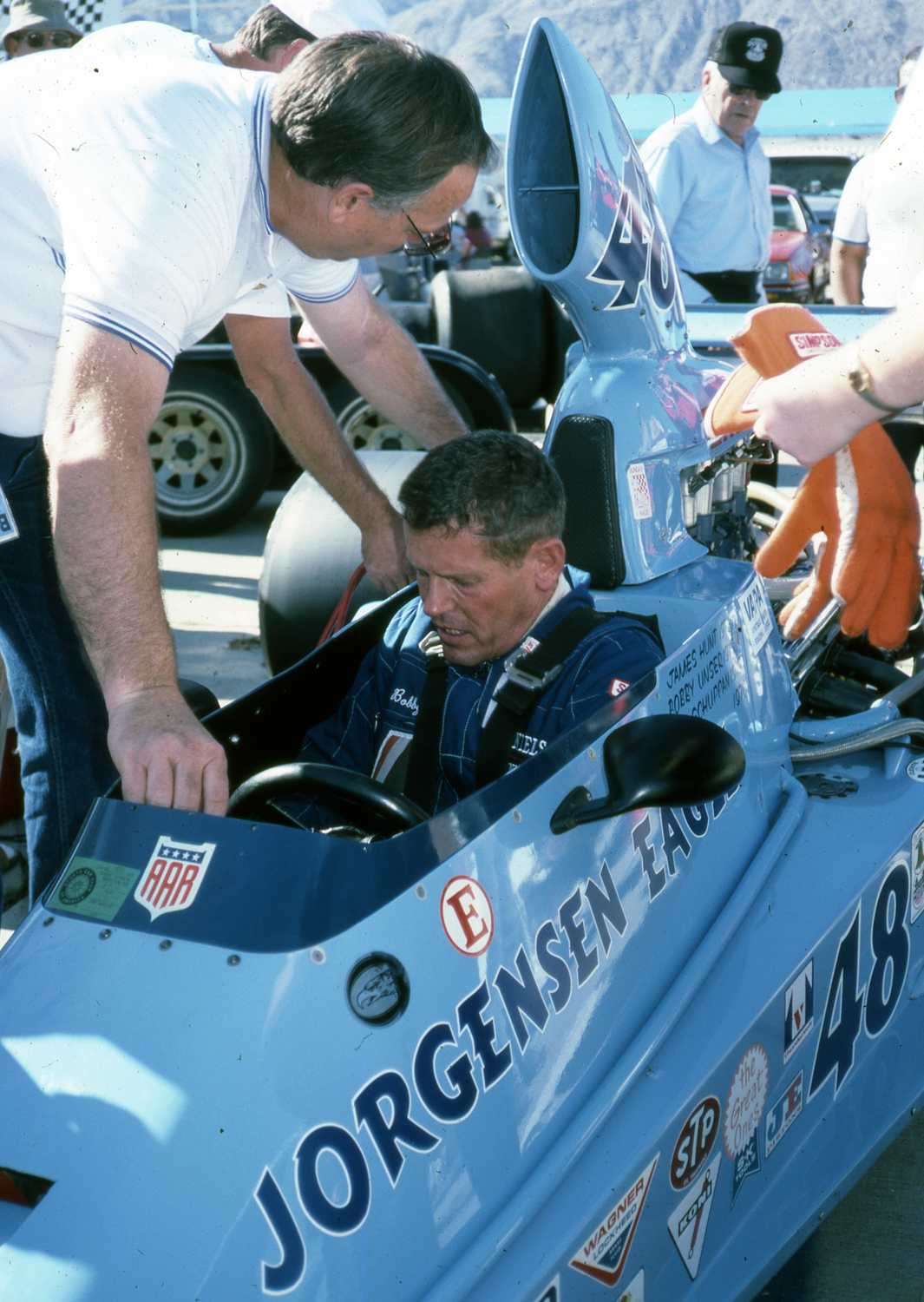
Gurney was the only one who had an appropriate car—his Gurney Weslake Eagle—that he agreed to bring and drive. The only way to get cars for the others was to borrow them. I got the most recent Monterey Historics program, looked at the entry list and started calling. One car collector who was most helpful was Ron Kellogg. He had John Von Neumann’s Ferrari Testa Rossa, as well as the Bobby Unser F5000 Eagle. As soon as I got Ron aboard, I called Bobby and he agreed to fly his plane over from Albuquerque. Right away, I sent out another press release. AutoWeek ran another story, so I invited Denise McCluggage, a staff writer at the time. By the time November rolled around, I had been getting a steady dribble of publicity. When my buddy, movie-director Bruce Kessler, told me that everyone in Hollywood was talking about it, I knew we had something going.
One problem we had to address was setting up the course. In order to do so, we had to work with local authorities. Vasek and I had planned a course at something over two miles. But it went by the Post Office. The local Postmaster objected, noting the Post Office was open on Saturday. So we had to shrink the course to avoid the Post Office.
Our original plan had a long straight using Taquitz-McCallum, a wide, divided road going from the center of town to the airport. The police chief objected, so more shrinkage. We ended up with little more than a large block. I thought many would be disappointed, but Stirling Moss later remarked, “This is not about racing, it’s about the people and the cars.”
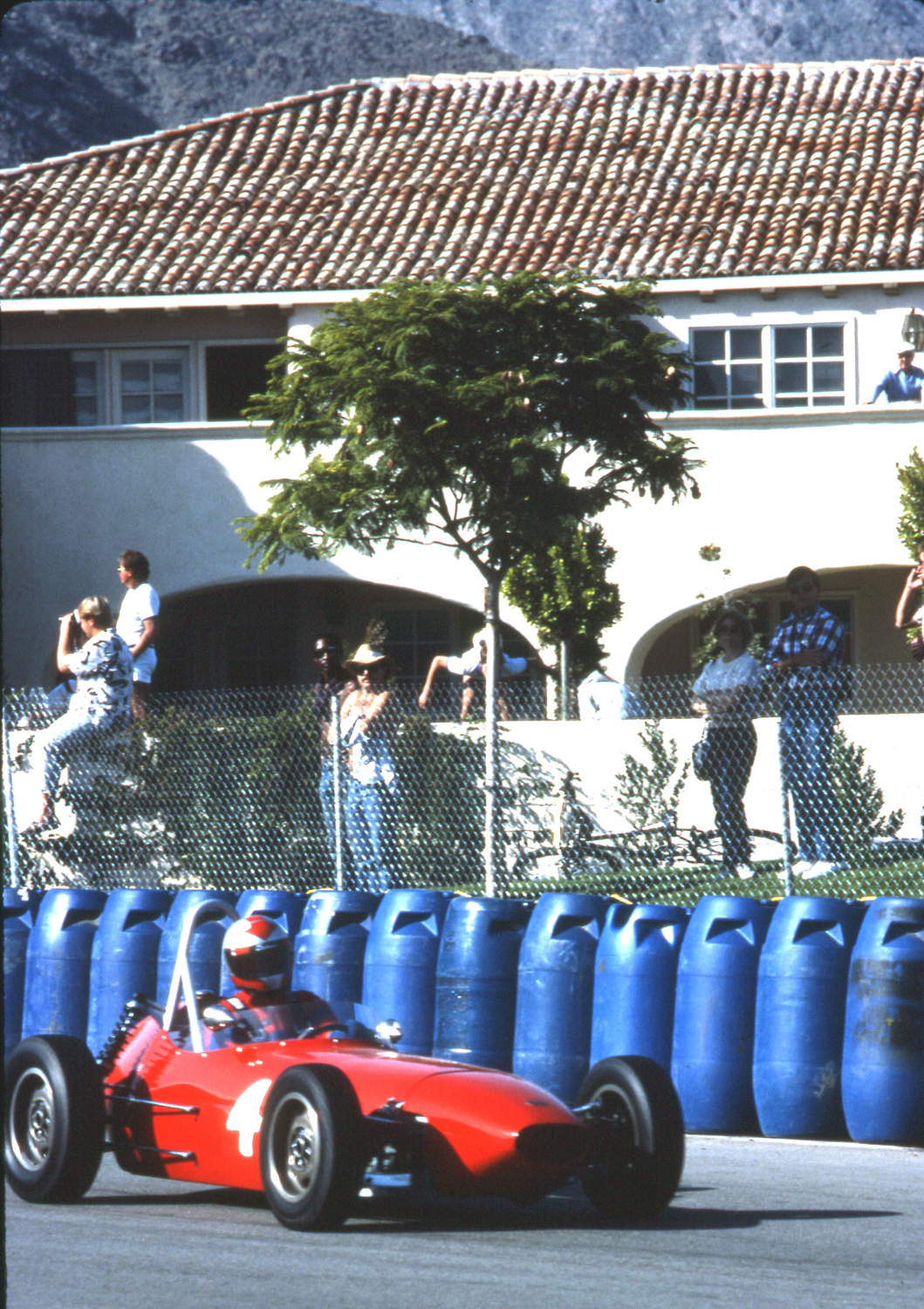
Next we had to define the course with barriers to protect not only the participants, but also the spectators. Since we were on city streets, there were curbs. A curb is anathema for racing because if a car hits one sideways, it rolls. In the old days, we used hay bales, but we decided that these would not be adequate, not to mention costing a lot of money. Luckily, one of the prospective entrants was a contractor. He had a number of K-rail barriers (Those long, moveable concrete blocks.) that he donated. That gave us a start, but there weren’t enough of them.
Remembering that my friend, John Fitch, was the designer of those barrels seen everywhere on freeways, I called him for advice. He told me that a barrel filled with water was almost as good as his famous Inertial Barriers. He also mentioned that some barrels used for food can be used only one time for that purpose. So we called around and eventually found a source of large plastic pickle barrels. I think they were only 25¢ each, so we bought a bunch and placed them at strategic places around the course. The day before the race, the Palm Springs Fire Department filled the barrels.
One of the members of the Chamber committee was the person in the City of Palm Springs responsible for insurance. She was assigned to obtain adequate liability coverage for the event. But for one reason or another, she fell down on the job. One month before the event, we didn’t have insurance. The president of VARA became very upset thinking he might be personally liable, so he resigned. Nevertheless, other VARA members worked the race including Sy Lauretz, the Race Steward.
The upshot insofar as insurance went was that we never got a special policy. As it turned out, however, there was no specific exclusion of racing in the city policy, so, since our event was an official city happening, we were covered. As it turned out, there was a claim, but more about that later.
Course control was done by the Long Beach MG Club in the old days, so we were fortunate to get it for the same function. And a number of those originally involved participated too. Alan Fordney was the announcer, Arnie Cane was the starter, Bill Pollack was the “Reunion Chairman,” and Dick Guldstrand the Celebrity Coordinator.
As the weekend approached, we were faced with disaster. A huge storm blanketed the West Coast and it rained in Palm Springs all Thanksgiving week. Since rain in Palm Springs is rare, we hadn’t set a rain date or even thought about it. Even so, the course was set up with everyone getting wet. Lo and behold, Saturday dawned with a blue sky and warm weather. And it continued into Sunday. On the Monday after, rain returned.
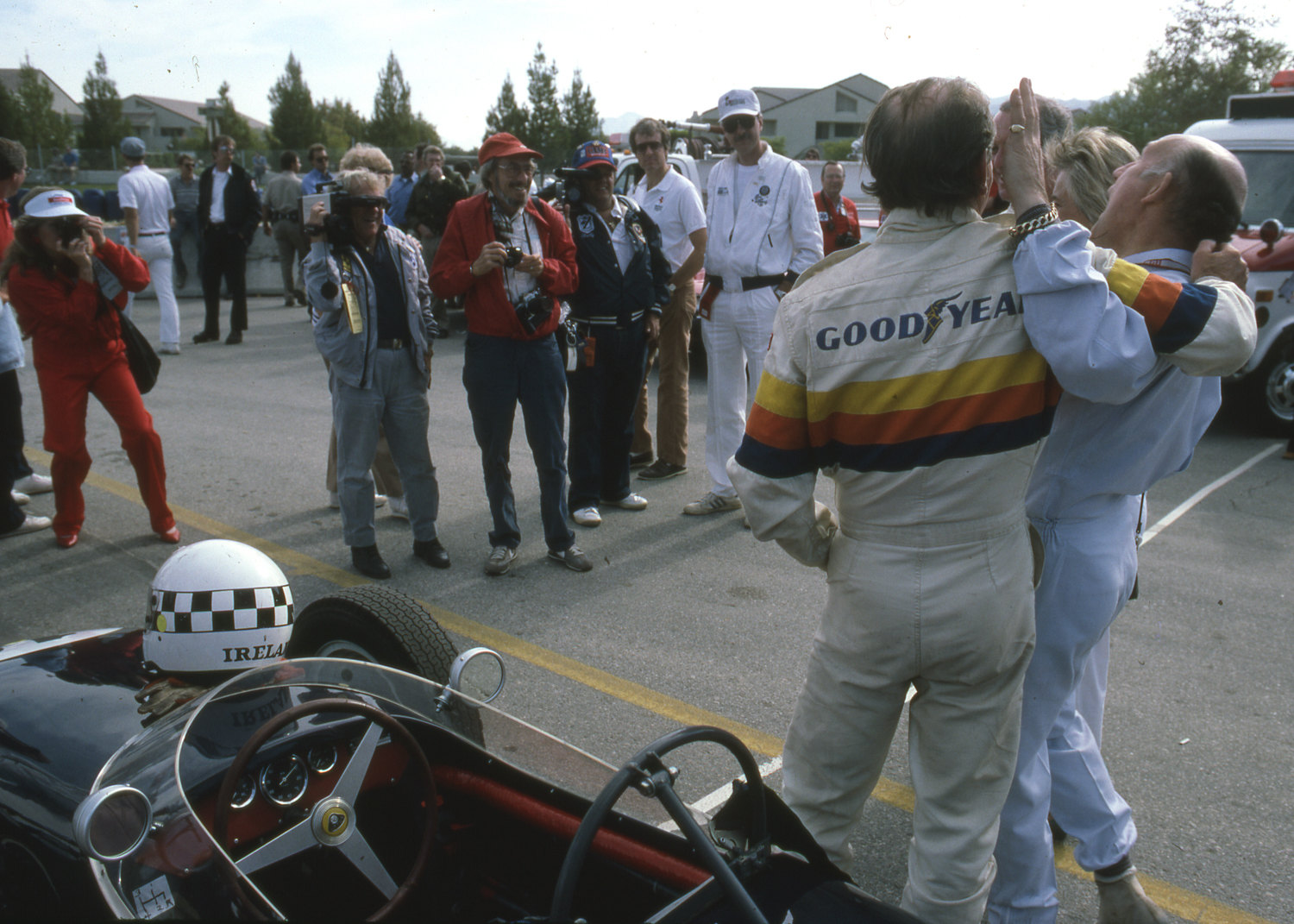
The storm did cause a few problems. Pete Lovely had agreed to bring his Formula One Lotus from Tacoma, Washington. He set out towing a trailer, but got bogged down in snow. Without chains, he couldn’t continue. But Pete, himself, made it by flying. Fortunately, a neighbor of mine, David Springett, had a spare Lotus 18 he offered for Pete. Actually, Springett had three Loti (plural of Lotus), so I had appropriate mounts for Innes Ireland and Jay Chamberlain too.
The storm also caused difficulties for many traveling south towards Palm Springs. There were numerous accidents and blockages on the freeway. Nevertheless, by Friday, there wasn’t a hotel room to be had in the area and people were staying in nearby Indio and Banning. The Chamber and the City were happy campers.
Probably due to the publicity we had in motorsports media for the months prior to Thanksgiving, there were a large number of vintage entrants. There were so many, in fact, that we could allow them to run only one day: Saturday or Sunday. They were used to racing each day and there was some grumbling amongst the troops. At the end of the day on Saturday, I spied a few loading up and pulling out. I asked about this and the reply was, “Well, I had my run and now I’m going home.” When I pointed out the large number of racing greats that would be in Sunday’s main event, they didn’t seem interested. Obviously, some had come just to race. I was taken aback that these vintage racers were indifferent regarding the history of the sport.
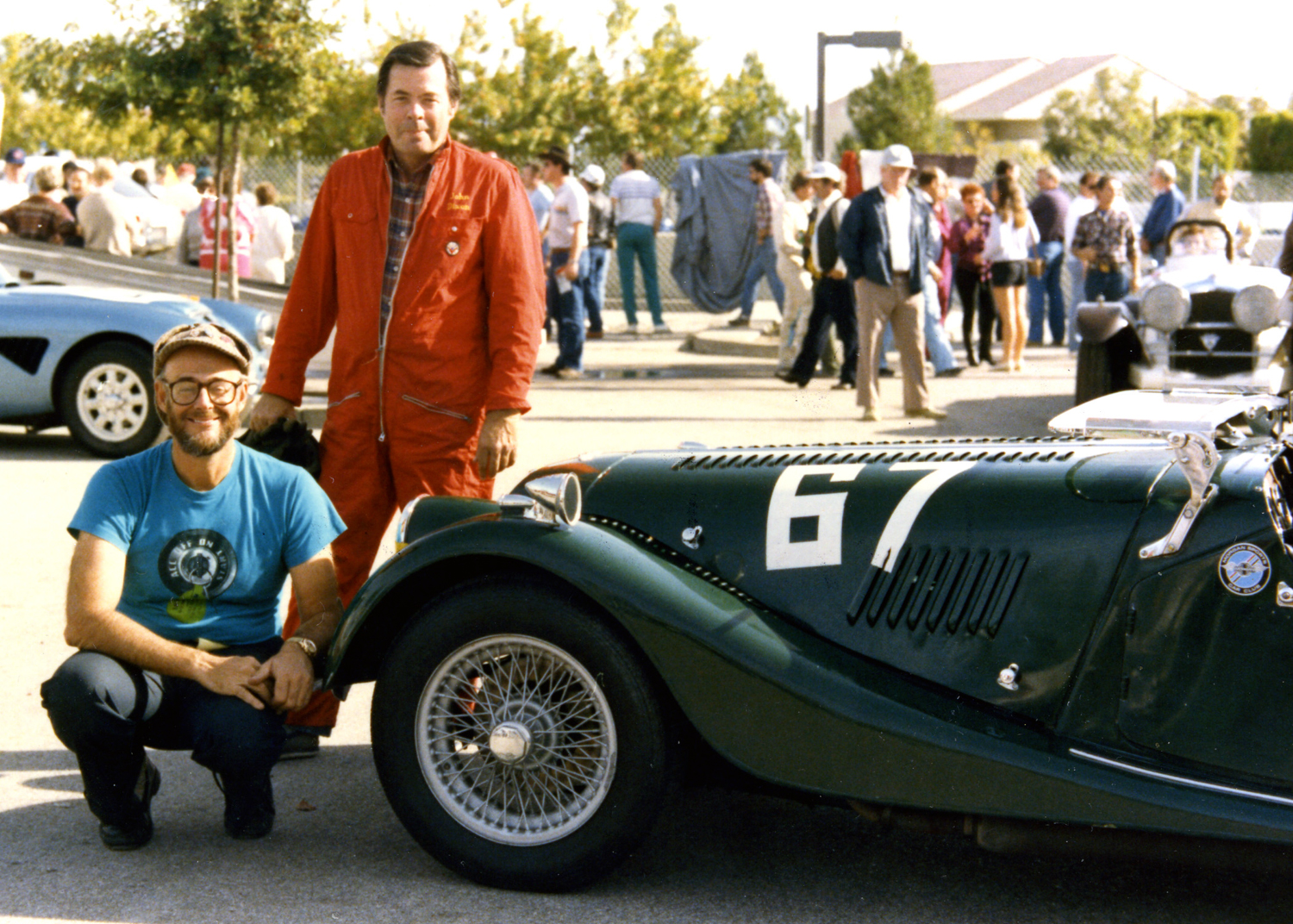
The big event on Saturday was the Fabulous ’50s Reunion. This was supposed to be a parade of more than 50 drivers who had raced during the ’50s, hopefully in the same or similar cars. Again, very few of them had appropriate cars, so I set about borrowing from vintage entrants. Most appropriate, of course, was Ron Kellogg’s Ferrari Testa Rossa for John Von Neumann, who had raced at almost every ’50s Palm Springs including the very first in April 1950.
John showed up on Saturday before the Reunion event. I took him to Ron Kellogg’s paddock and introduced them. John said he wanted to re-familiarize himself with the car, so Ron gave him the key and John drove off. The time for the event rolled around and no John, so the group took off without him. Hours later, John returned with a wide grin (unusual for him) on his face. He thanked Ron and went home.
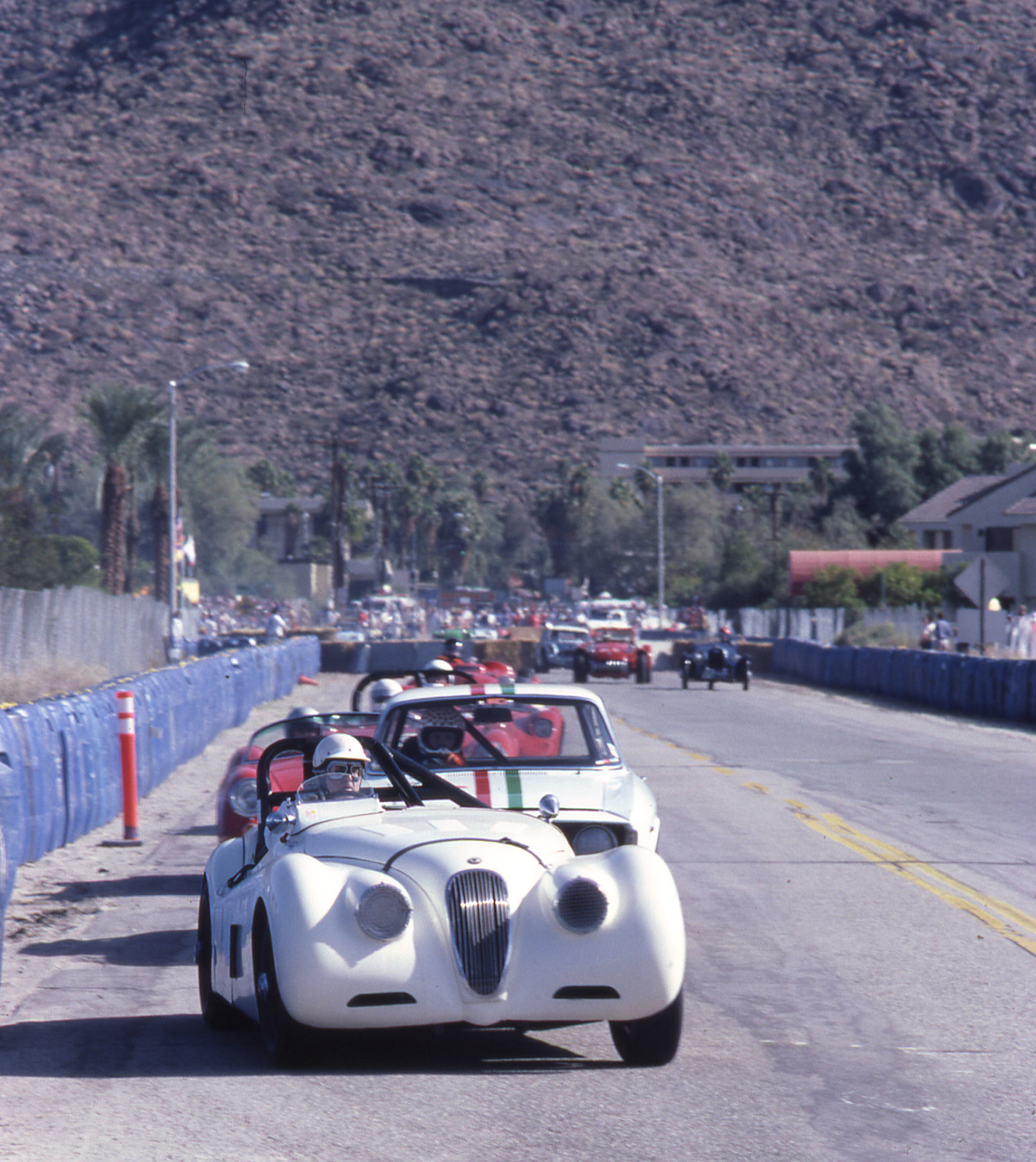
Quite a few more than 50 showed up. Some of the notables in cars (or same make and model that they drove in the ’50s) were Stirling Moss in a C-Type Jaguar, Phil Hill in an XK120, Mary Davis in an MG, Pete Lovely in a 550 Porsche, Ronnie Bucknum in an Austin-Healey, Andy Porterfield in my Devin SS, Bill Stoppe in a Kurtis, Bob Drake in a D-Type Jaguar, Denise McCluggage in an Alfa Romeo, Dan Gurney in a Porsche Speedster, Dick Guldstrand in a Corvette, Bill Pollack in an Allard, Bill Murphy in a Kurtis, Skip Hudson in a Porsche, Lew Spencer in a Morgan, Max Balchowski in Ole Yeller, Bob Estes in a Bugatti, Al Moss in his TC that he had driven from Arizona, Scooter Patrick in a Porsche, Paul O’Shea in a 300SL, Jack McAfee in a 550 Porsche, Jim Hall in a Lotus and many more names you would recognize.
We had an impromptu drivers’ meeting on the pre-grid conducted by Stirling and Phil. They explained that this was a parade or procession and that there were too many cars for the course. Stirling said he and Phil would lead off, side by side, and the rest were to follow. When the flag dropped, however, quite a few forgot the instructions and started to dice. I had borrowed the Speedster for Gurney from a Gary Fahl of Sunnyvale, CA. I was standing at Start/Finish when Dan came back walking along the side of the course, helmet in hand. It turned out that he had tried to pass both Stirling and Phil in a corner that would only fit two cars. The Fahl Porsche was somewhat worse for the wear. Fahl was furious, yelling at me that his concours car was destroyed. Destroyed was an exaggeration, however. After the event, I was able to get Vasek Polak to restore it without charge and Fahl was molified. At any rate, the rest of the reunion went off without incident. I don’t think many in the audience realized what a truly amazing sight they had just witnessed.
Racing personalities weren’t the only famous faces that could be seen that weekend. Tristan Rogers, star of the daytime soap, General Hospital, Chris Atkins of Blue Lagoon, Perry King, Kent McCord and Robert Carradine are a few that I can recall. Our very own Mr. Monterey Historics Steve Earle was racing in his 1953 Aston-Martin.
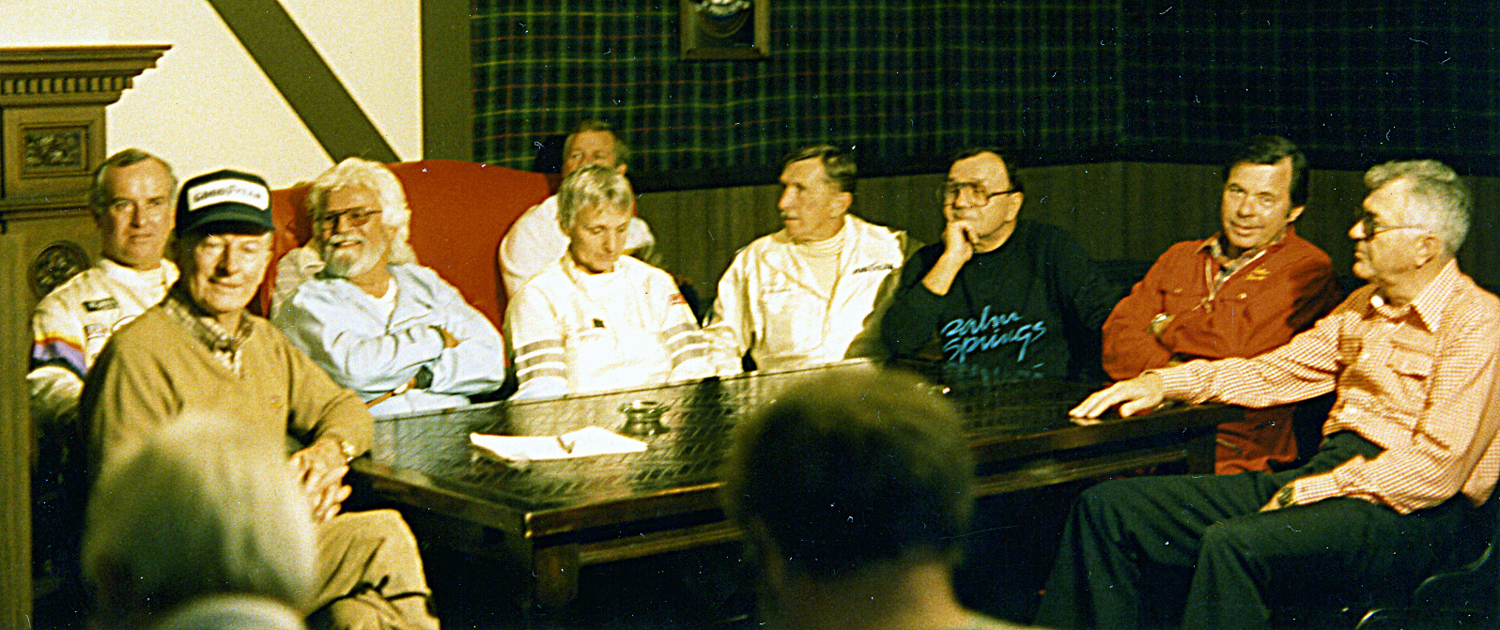
The rest of the day went well and that evening, it was parties, parties, parties. John Von Neumann hosted a dinner at this home featuring lobster. He entertained many of his friends who had been at his Porsche/VW dealers in the old days including Jay Chamberlain, Vasek Polak, Pete Lovely, Jack McAfee and George Follmer. I was fortunate to be included.

The only problem I ended up with involved Innes Ireland. I had arranged for a complimentary room in the headquarters hotel. Later, I was informed that Ireland had charged many hundreds of dollars for liquor and the hotel management was quite upset. Of course, by then, Ireland had returned to England. So I left this one for the Chamber to sort out.
On Sunday, Race Seven was for older sports cars. The cars were due to line up at pre-grid, but an official hustled me over to their paddock. All of the drivers were suited up but sitting on the concrete beside their cars. Vasek Polak had entered his 1937 BMW 328 for John Von Neumann to drive. When I got there I was told that the entrants wouldn’t compete against a replica and that the BMW was, in fact, a replica. I talked with Vasek about it and he admitted it was a replica, But, he said, “It’s an exact replica.” I had to pull the car and the drivers climbed into their cars. Vasek was very angry with me for the rest of the day. (We remained close friends until his death.)
In order to generate pre-race publicity, I had invited Road & Track Editor John Dinkel to come and race my 1956 Alfa Romeo Giulietta. In addition, my friend Kent McCord was to drive my Devin SS. But when we three met in the paddock, it turned out that the 6-ft, 3-in McCord wouldn’t fit in the Devin. So I came up with an easy fix. “The two of you can just swap cars.” After his race, Dinkel remarked in the magazine, “I sure have a much better appreciation of what the ‘old-timers’ had to put up with when they raced in the fifties and sixties. My helmet is off to all of them.” He had found that racing the Devin was hard work.
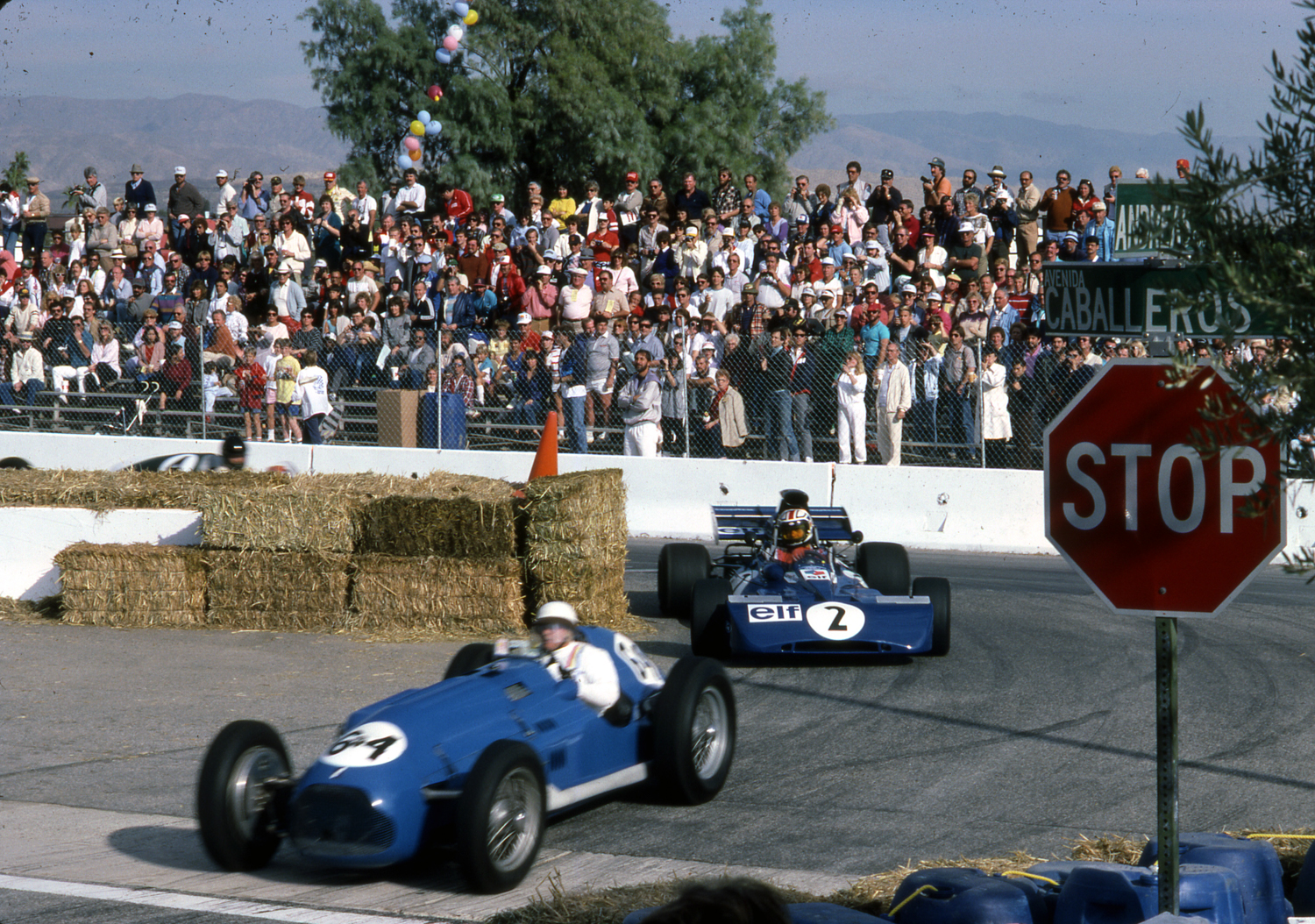
The big event on Sunday was, of course, the Vintage Formula One. Dan Gurney was a favorite in the same Eagle that he had won the 1967 Formula One race at Spa, Belgium. Gurney had accomplished wins in Formula One, Indycars, NASCAR, Trans-Am, Can-Am and sports cars, a record equaled only by Mario Andretti. Another favorite was three-time Indy winner Bobby Unser driving a 1973 Eagle, the same car in which he had won the 500 that year. They were challenged by a host of other top talents, not the least of which was Stirling Moss in a Formula One Lotus. Other former Formula One Lotus Team members Innes Ireland, Jay Chamberlain and Pete Lovely joined Moss in Loti. There were other Indy drivers on hand led by two-time winner Rodger Ward in my 1967 Phoenix-winning Indy Gilbert and Sam Hanks. Bob Bondurant had a ride in a 1967 Ferrari alongside George Follmer in a 1971 Tyrrell and Ronnie Bucknum in a Cooper. World Champion Phil Hill piloted a Talbot Lago once driven by Juan Fangio. Afterwards, Phil said, “I did what I could with the suds left in the old car.”

Notwithstanding the competition, Bob Bondurant won in the Ferrari. Perhaps due to teaching at his school he had more recent seat time than the others. All of the Formula One entries had been padlocked a short distance away from the course in a parking lot. The street from the course to the lot was not part of the course and consequently under the jurisdiction of the Palm Springs Police. After the race, all of the cars left the course onto the street, led by Bondurant. The street was lined by police, keeping a large crowd of spectators at bay.
All of a sudden, a pre-teen boy pushed between two officers, and out onto the street and collided with the Bondurant Ferrari. The boy had been left unattended by his mother, who had gone shopping. We brought the boy into the paddock and, just to make sure, had him examined by paramedics. At that point, his mother returned and, even though the paramedics said it was not necessary, demanded they take him to the hospital where shortly after arrival, he was discharged without treatment.
As I discovered later, however, his mother was a student at a law school. A week or so later and much to my surprise, I received a letter from her asking me to supply her with the name of our insurance agency and that she was seeking damages. I assembled a small committee of lawyers headed by (now-judge) Joe DiLoreto. I was advised to do nothing. In the ordinary course of events, in order to pursue the matter, she would have to file suit within one year of the event. She knew this from law school, I guess. So, hoping to get a large settlement with threatening letters—which continued—she waited until one year minus one day to file. But, as it turned out, the incident involving her son occurred on a City street where the Palm Springs police were in charge. In the case of a municipality, California law requires suit to be filed within six months! So the matter ended with a whimper.
When all was said and done, everyone, except the law-school mother, was happy. The City was happy because every hotel and motel within 20 miles of Palm Springs was sold out. The Chamber was happy because the event was a sell-out. After noon or so on Sunday, the Chamber ticket takers ran of out tickets—they had sold all 25,000 they had printed—so they just opened the gates and let everyone in. And the members did a land-office business. Our big-name entrants were happy because they had an opportunity to hob-knob with friends, plus an expense-paid vacation in a famous resort. Even though they had only one day to race, most of our vintage entrants were happy to have been involved in what turned out to be a world-class happening.
We even ended up making a small profit from the entry fees. So we threw a big, hosted Christmas party at Mary Davis’ Portofino Inn in Redondo Beach, emptied the treasury and closed the account. The effort had taken most of a year out of my life and my wife told me that if I ever promoted another race, she would leave me. A Mexican fellow introduced himself to me at the party and told me that he was involved in racing in his home country. He asked if I remembered the early-’50s Mexican Road Races and I replied that I did. Then he suggested we promote a vintage recreation. But that’s another story.


